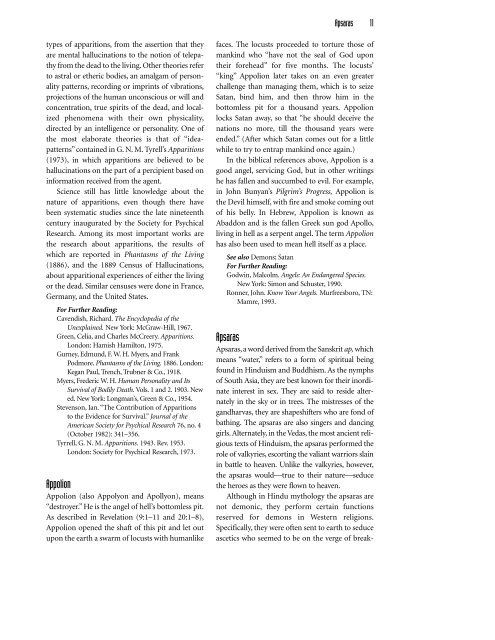Satanism Today - An Encyclopedia of Religion, Folklore and Popular ...
Satanism Today - An Encyclopedia of Religion, Folklore and Popular ...
Satanism Today - An Encyclopedia of Religion, Folklore and Popular ...
You also want an ePaper? Increase the reach of your titles
YUMPU automatically turns print PDFs into web optimized ePapers that Google loves.
Apsaras 11<br />
types <strong>of</strong> apparitions, from the assertion that they<br />
are mental hallucinations to the notion <strong>of</strong> telepathy<br />
from the dead to the living. Other theories refer<br />
to astral or etheric bodies, an amalgam <strong>of</strong> personality<br />
patterns, recording or imprints <strong>of</strong> vibrations,<br />
projections <strong>of</strong> the human unconscious or will <strong>and</strong><br />
concentration, true spirits <strong>of</strong> the dead, <strong>and</strong> localized<br />
phenomena with their own physicality,<br />
directed by an intelligence or personality. One <strong>of</strong><br />
the most elaborate theories is that <strong>of</strong> “ideapatterns”<br />
contained in G. N. M. Tyrell’s Apparitions<br />
(1973), in which apparitions are believed to be<br />
hallucinations on the part <strong>of</strong> a percipient based on<br />
information received from the agent.<br />
Science still has little knowledge about the<br />
nature <strong>of</strong> apparitions, even though there have<br />
been systematic studies since the late nineteenth<br />
century inaugurated by the Society for Psychical<br />
Research. Among its most important works are<br />
the research about apparitions, the results <strong>of</strong><br />
which are reported in Phantasms <strong>of</strong> the Living<br />
(1886), <strong>and</strong> the 1889 Census <strong>of</strong> Hallucinations,<br />
about apparitional experiences <strong>of</strong> either the living<br />
or the dead. Similar censuses were done in France,<br />
Germany, <strong>and</strong> the United States.<br />
For Further Reading:<br />
Cavendish, Richard. The <strong>Encyclopedia</strong> <strong>of</strong> the<br />
Unexplained. New York: McGraw-Hill, 1967.<br />
Green, Celia, <strong>and</strong> Charles McCreery. Apparitions.<br />
London: Hamish Hamilton, 1975.<br />
Gurney, Edmund, F. W. H. Myers, <strong>and</strong> Frank<br />
Podmore. Phantasms <strong>of</strong> the Living. 1886. London:<br />
Kegan Paul, Trench, Trubner & Co., 1918.<br />
Myers, Frederic W. H. Human Personality <strong>and</strong> Its<br />
Survival <strong>of</strong> Bodily Death. Vols. 1 <strong>and</strong> 2. 1903. New<br />
ed. New York: Longman’s, Green & Co., 1954.<br />
Stevenson, Ian. “The Contribution <strong>of</strong> Apparitions<br />
to the Evidence for Survival.” Journal <strong>of</strong> the<br />
American Society for Psychical Research 76, no. 4<br />
(October 1982): 341–356.<br />
Tyrrell, G. N. M. Apparitions. 1943. Rev. 1953.<br />
London: Society for Psychical Research, 1973.<br />
Appolion<br />
Appolion (also Appolyon <strong>and</strong> Apollyon), means<br />
“destroyer.” He is the angel <strong>of</strong> hell’s bottomless pit.<br />
As described in Revelation (9:1–11 <strong>and</strong> 20:1–8),<br />
Appolion opened the shaft <strong>of</strong> this pit <strong>and</strong> let out<br />
upon the earth a swarm <strong>of</strong> locusts with humanlike<br />
faces. The locusts proceeded to torture those <strong>of</strong><br />
mankind who “have not the seal <strong>of</strong> God upon<br />
their forehead” for five months. The locusts’<br />
“king” Appolion later takes on an even greater<br />
challenge than managing them, which is to seize<br />
Satan, bind him, <strong>and</strong> then throw him in the<br />
bottomless pit for a thous<strong>and</strong> years. Appolion<br />
locks Satan away, so that “he should deceive the<br />
nations no more, till the thous<strong>and</strong> years were<br />
ended.” (After which Satan comes out for a little<br />
while to try to entrap mankind once again.)<br />
In the biblical references above, Appolion is a<br />
good angel, servicing God, but in other writings<br />
he has fallen <strong>and</strong> succumbed to evil. For example,<br />
in John Bunyan’s Pilgrim’s Progress, Appolion is<br />
the Devil himself, with fire <strong>and</strong> smoke coming out<br />
<strong>of</strong> his belly. In Hebrew, Appolion is known as<br />
Abaddon <strong>and</strong> is the fallen Greek sun god Apollo,<br />
living in hell as a serpent angel. The term Appolion<br />
has also been used to mean hell itself as a place.<br />
See also Demons; Satan<br />
For Further Reading:<br />
Godwin, Malcolm. <strong>An</strong>gels: <strong>An</strong> Endangered Species.<br />
New York: Simon <strong>and</strong> Schuster, 1990.<br />
Ronner, John. Know Your <strong>An</strong>gels. Murfreesboro, TN:<br />
Mamre, 1993.<br />
Apsaras<br />
Apsaras, a word derived from the Sanskrit ap, which<br />
means “water,” refers to a form <strong>of</strong> spiritual being<br />
found in Hinduism <strong>and</strong> Buddhism. As the nymphs<br />
<strong>of</strong> South Asia, they are best known for their inordinate<br />
interest in sex. They are said to reside alternately<br />
in the sky or in trees. The mistresses <strong>of</strong> the<br />
g<strong>and</strong>harvas, they are shapeshifters who are fond <strong>of</strong><br />
bathing. The apsaras are also singers <strong>and</strong> dancing<br />
girls. Alternately, in the Vedas, the most ancient religious<br />
texts <strong>of</strong> Hinduism, the apsaras performed the<br />
role <strong>of</strong> valkyries, escorting the valiant warriors slain<br />
in battle to heaven. Unlike the valkyries, however,<br />
the apsaras would—true to their nature—seduce<br />
the heroes as they were flown to heaven.<br />
Although in Hindu mythology the apsaras are<br />
not demonic, they perform certain functions<br />
reserved for demons in Western religions.<br />
Specifically, they were <strong>of</strong>ten sent to earth to seduce<br />
ascetics who seemed to be on the verge <strong>of</strong> break-
















